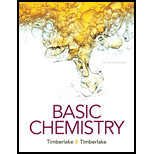
(a)
Interpretation:
Interpret major type of intermolecular forces between BrF.
Concept Introduction:
Intermolecular forces are the forces responsible for the interaction between the neighbouring particles or these are the forces present between the molecules. The name intermolecular indicates the forces present between the atoms or ions. The main intermolecular forces are:
Dipole-dipole forces
These forces are the interaction present between the polar molecules.
London dispersion forces
These forces are the forces known for short term attraction due to unequal distribution of electron.
Hydrogen bond
These forces exist between hydrogen and the atom which is highly electronegative in nature not directly associated or bonded with it.
(b)
Interpretation:
Interpret major type of intermolecular forces between KCl.
Concept Introduction:
Intermolecular forces are the forces responsible for the interaction between the neighbouring particles or these are the forces present between the molecules. The name intermolecular indicates the forces present between the atoms or ions. The main intermolecular forces are:
Dipole-dipole forces
These forces are the interaction present between the polar molecules.
London dispersion forces
These forces are the forces known for short term attraction due to unequal distribution of electron.
Hydrogen bond
These forces exist between hydrogen and the atom which is highly electronegative in nature not directly associated or bonded with it.
(c)
Interpretation:
Interpret major type of intermolecular forces between NF3.
Concept Introduction:
Intermolecular forces are the forces responsible for the interaction between the neighbouring particles or these are the forces present between the molecules. The name intermolecular indicates the forces present between the atoms or ions. The main intermolecular forces are:
Dipole-dipole forces
These forces are the interaction present between the polar molecules.
London dispersion forces
These forces are the forces known for short term attraction due to unequal distribution of electron.
Hydrogen bond
These forces exist between hydrogen and the atom which is highly electronegative in nature not directly associated or bonded with it.
(d)
Interpretation:
Interpret major type of intermolecular forces between Cl2.
Concept Introduction:
Intermolecular forces are the forces responsible for the interaction between the neighbouring particles or these are the forces present between the molecules. The name intermolecular indicates the forces present between the atoms or ions. The main intermolecular forces are:
Dipole-dipole forces
These forces are the interaction present between the polar molecules.
London dispersion forces
These forces are the forces known for short term attraction due to unequal distribution of electron.
Hydrogen bond
These forces exist between hydrogen and the atom which is highly electronegative in nature not directly associated or bonded with it.
Want to see the full answer?
Check out a sample textbook solution
Chapter 10 Solutions
Basic Chemistry (5th Edition)
 ChemistryChemistryISBN:9781305957404Author:Steven S. Zumdahl, Susan A. Zumdahl, Donald J. DeCostePublisher:Cengage Learning
ChemistryChemistryISBN:9781305957404Author:Steven S. Zumdahl, Susan A. Zumdahl, Donald J. DeCostePublisher:Cengage Learning ChemistryChemistryISBN:9781259911156Author:Raymond Chang Dr., Jason Overby ProfessorPublisher:McGraw-Hill Education
ChemistryChemistryISBN:9781259911156Author:Raymond Chang Dr., Jason Overby ProfessorPublisher:McGraw-Hill Education Principles of Instrumental AnalysisChemistryISBN:9781305577213Author:Douglas A. Skoog, F. James Holler, Stanley R. CrouchPublisher:Cengage Learning
Principles of Instrumental AnalysisChemistryISBN:9781305577213Author:Douglas A. Skoog, F. James Holler, Stanley R. CrouchPublisher:Cengage Learning Organic ChemistryChemistryISBN:9780078021558Author:Janice Gorzynski Smith Dr.Publisher:McGraw-Hill Education
Organic ChemistryChemistryISBN:9780078021558Author:Janice Gorzynski Smith Dr.Publisher:McGraw-Hill Education Chemistry: Principles and ReactionsChemistryISBN:9781305079373Author:William L. Masterton, Cecile N. HurleyPublisher:Cengage Learning
Chemistry: Principles and ReactionsChemistryISBN:9781305079373Author:William L. Masterton, Cecile N. HurleyPublisher:Cengage Learning Elementary Principles of Chemical Processes, Bind...ChemistryISBN:9781118431221Author:Richard M. Felder, Ronald W. Rousseau, Lisa G. BullardPublisher:WILEY
Elementary Principles of Chemical Processes, Bind...ChemistryISBN:9781118431221Author:Richard M. Felder, Ronald W. Rousseau, Lisa G. BullardPublisher:WILEY





